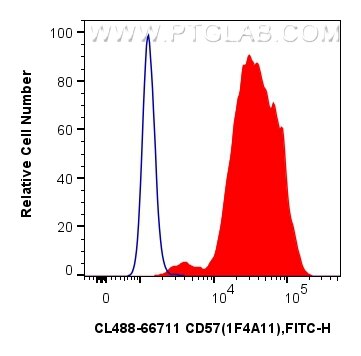Tested Applications
| Positive FC (Intra) detected in | K-562 cells |
Recommended dilution
| Application | Dilution |
|---|---|
| Flow Cytometry (FC) (INTRA) | FC (INTRA) : 0.40 ug per 10^6 cells in a 100 µl suspension |
| It is recommended that this reagent should be titrated in each testing system to obtain optimal results. | |
| Sample-dependent, Check data in validation data gallery. | |
Product Information
CL488-66711 targets B3GAT1 in FC (Intra) applications and shows reactivity with human samples.
| Tested Reactivity | human |
| Host / Isotype | Mouse / IgG2a |
| Class | Monoclonal |
| Type | Antibody |
| Immunogen | B3GAT1 fusion protein Ag13593 Predict reactive species |
| Full Name | beta-1,3-glucuronyltransferase 1 (glucuronosyltransferase P) |
| Calculated Molecular Weight | 38 kDa |
| Observed Molecular Weight | 38 kDa, 100 kDa |
| GenBank Accession Number | BC010466 |
| Gene Symbol | B3GAT1 |
| Gene ID (NCBI) | 27087 |
| RRID | AB_3084267 |
| Conjugate | CoraLite® Plus 488 Fluorescent Dye |
| Excitation/Emission Maxima Wavelengths | 493 nm / 522 nm |
| Form | Liquid |
| Purification Method | Protein A purification |
| UNIPROT ID | Q9P2W7 |
| Storage Buffer | PBS with 50% Glycerol, 0.05% Proclin300, 0.5% BSA, pH 7.3. |
| Storage Conditions | Store at -20°C. Avoid exposure to light. Stable for one year after shipment. Aliquoting is unnecessary for -20oC storage. |
Background Information
B3GAT1 is an enzyme encoded by the B3GAT1 gene, whose enzymatic activity generates the CD57 epitope on other cell surface proteins. In immunology, the CD57 antigen (CD stands for cluster of differentiation) is also known as HNK1 (human natural killer-1) or LEU7. B3GAT1 is associated with glycosaminoglycan biosynthesis. It plays a key role in neurodevelopment.
Protocols
| Product Specific Protocols | |
|---|---|
| FC protocol for CL Plus 488 B3GAT1 antibody CL488-66711 | Download protocol |
| Standard Protocols | |
|---|---|
| Click here to view our Standard Protocols |



